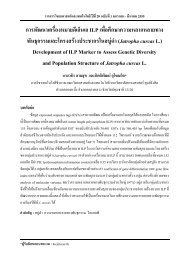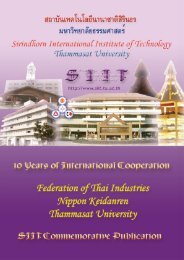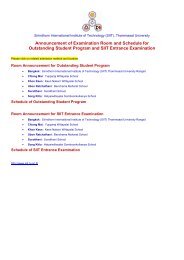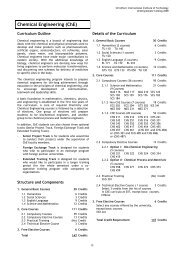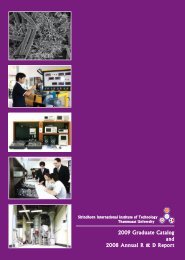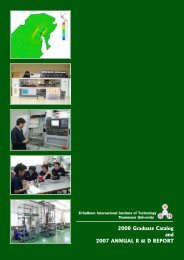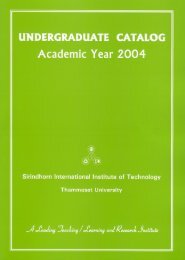2007 Graduate Catalog and 2006 Annual R & D Report - Sirindhorn ...
2007 Graduate Catalog and 2006 Annual R & D Report - Sirindhorn ...
2007 Graduate Catalog and 2006 Annual R & D Report - Sirindhorn ...
Create successful ePaper yourself
Turn your PDF publications into a flip-book with our unique Google optimized e-Paper software.
<strong>2007</strong> <strong>Graduate</strong> <strong>Catalog</strong> <strong>and</strong> <strong>2006</strong> <strong>Annual</strong> R & D <strong>Report</strong><br />
<strong>Sirindhorn</strong> International Institute of Technology (SIIT)<br />
detection of error bits by means of algebraic coding<br />
techniques such as 1-D <strong>and</strong> 2-D convolutional code<br />
are usually employed. Topics of interest include:<br />
adaptive filtering, power spectrum estimation, array<br />
processing, 2-D convolutional code design, <strong>and</strong><br />
application-specific coding design.<br />
Dr. Duangrat Eungdamrong<br />
Assistant Professor<br />
B.S. & M.S. in Electrical Engineering, University of Wisconsin-Madison, WI, USA<br />
Ph.D. in Electrical Engineering, University of Wisconsin-Milwaukee, WI, USA<br />
Areas of Specialization: Wireless communication, Communication systems, Microwave <strong>and</strong> RF circuits,<br />
Antenna, Electrical Sensors.<br />
Research Interests:<br />
Phase Noise Models<br />
Because of an exponential growth in wireless<br />
communication, dem<strong>and</strong> for the frequency channels<br />
in mobile communication application is increasing,<br />
which in turn, imposes more stringent requirements<br />
on phase noise of circuits. Oscillator phase noise is<br />
an essential parameter that limits the performances of<br />
many modern telecommunication systems because<br />
introducing even small noise into the circuit leads to<br />
dramatic changes in its frequency spectrum <strong>and</strong><br />
timing properties. Phase <strong>and</strong> frequency fluctuations<br />
have been the subject of numerous studies both<br />
experimentally <strong>and</strong> theoretically.<br />
Open-Ended Coaxial Line Microwave Sensor<br />
Open-ended coaxial lines have been used as<br />
electromagnetic sensors or probes in various<br />
industrial <strong>and</strong> scientific applications. This includes invivo<br />
characterization of biological media,<br />
nondestructive measurements of materials, <strong>and</strong> noncontact<br />
testing of disb<strong>and</strong>s in composites. In these<br />
applications, a radio frequency or microwave signal<br />
excites the probe that is placed against the sample<br />
medium. An echo signal received by the coaxial<br />
sensor carries the characteristics of the sample<br />
material. Therefore, the reflection coefficient (or<br />
aperture admittance) at the sensor can be monitored<br />
to extract the sample characteristics. Hence, the<br />
characterization process requires a suitable electrical<br />
model of the coaxial sensor in contact with the<br />
sample.<br />
Transformation of Transistor’s S-parameters<br />
Manufacturers generally supply the data sheets of<br />
transistors containing S-parameters with respect to<br />
the emitter (or the source). In other words, the<br />
transistor is considered as a two-port device with<br />
common emitter (or common source) configuration.<br />
However, the design engineers may want to use other<br />
configurations of the transistor for certain circuits.<br />
Hence, the transformation of S-parameters of the<br />
transistor is needed. Feedback networks can be<br />
conveniently designed to obtain the desired device<br />
behavior.<br />
Antenna<br />
In recent years, the need of wireless communications,<br />
operating at 1.9 GHz, GSM-USA st<strong>and</strong>ard, 2.4-2.5<br />
GHz, 802.llb WLAN, Bluetooth, 3G <strong>and</strong> 4G, has<br />
grown at an exponential rate. Thus, it has been an<br />
endless improvement in increasing the capability <strong>and</strong><br />
quality of transmission. Because of the struggle to<br />
achieve high data rates without compromising the<br />
quality of the received information, a new multiantenna<br />
system that yields substantially increased<br />
channel capacity had been proposed. In addition, a<br />
new Multiple-input Multiple-output (MIMO) system<br />
was also introduced to support this multi-antenna<br />
system. Information are transmitted <strong>and</strong> received<br />
through these multiple antennas. The system uses<br />
the special routes to transmit more information with<br />
little interference.<br />
Dr. Sawasd Tantaratana<br />
Professor<br />
B.E.E. with high distinction, University of Minnesota, USA<br />
M.S.E.E. Stanford University, USA<br />
Ph.D. in Electrical Engineering, Princeton University, USA<br />
Areas of Specialization: Communication systems, Spread-spectrum systems, Wireless communications,<br />
Signal processing, Digital filter design <strong>and</strong> realization.<br />
Research Insterests:<br />
Communication Systems<br />
Communication system design <strong>and</strong> analysis.<br />
Performance evaluation of communication systems in<br />
the presence of noise. Modulation techniques <strong>and</strong><br />
their performances. Signal detection, parameter<br />
estimation, <strong>and</strong> filtering.<br />
Wireless Communications <strong>and</strong> Spread-Spectrum<br />
Systems<br />
Spread - spectrum system design <strong>and</strong> analysis.<br />
Synchronization (acquisition <strong>and</strong> tracking). CDMA<br />
<strong>and</strong> OFDM. Multipath <strong>and</strong> fading effects in wireless<br />
systems. Optimum <strong>and</strong> sub-optimum receivers.<br />
21




